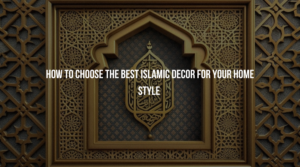Islamic wall art and Islamic art covers a vast geographical spectrum, from Spain to Southeast Asia over 1400 years. Though, despite all the differences, it is undeniable that there are common subjects and themes uniting the visual Islamic art of the Islamic world. Over the centuries, these artists elaborated on four significant subjects of decoration: calligraphy, geometry, vegetal and arabesque ornamentation, and figures. Let’s take a look at those four themes.
Calligraphy
Calligraphy is the most highly regarded and fundamental element of Kaaba Kiswa Islamic art. Arabic letters decorate objects that ranges from ceramic bowls to marble buildings. Arabic script grew in importance following the revelation of the Quran from God to the Prophet Muhammad or Kaaba Kiswa Islamic wall art. Even before his death, Muhammad’s followers and associates had begun to transcribe the Quran. Calligraphers soon began to transform Arabic writing into an Islamic art form.
During the rise of Islam and the early period between the 7th and 10th centuries, Kufic was used for copying Qurans and other manuscripts. It is characterized by its unconnected blocky letters that are spaced evenly. Kufic manuscripts of the Quran were intentionally complex to read to slow down the readers so that they could concentrate on God’s word which is written on Kaaba Kiswa Muslim home decor items. Here is a page from a Quran dating between 850 and 1000, written in Kufic.
However, as the Muslim population grew, calligraphy adopted more common scripts to make the Quran more legible and accessible. Between the 10th to and 15th centuries, the ‘Six Pens’ was developed, a group of rounded hands that enhanced the readability by providing the reader with a full range of diacritical marks and vocalizations. They are naksh, rayhani, riqa, thuluth, muhaqqaq, and tawqi. Local scripts are developed. For example, Nastaliq developed and was used in Central Asia and Iran and spread to Ottoman Turkey and Mughal India. Below is an example of Persian love poetry written in Nastaliq.
Calligraphers attempted to make their work look effortless. It was meant to be timeless and cerebral, a reflection of God’s immutability and permanence. Calligraphers painstakingly ensured that their work left no trace of the physical action it took to create it or any mark of distinction. In other words, it is tough to attribute Islamic calligraphy to a calligrapher unless they sign their work.
Geometry
Geometric patterns are popularly associated with Islamic art, mainly due to their iconic quality. These abstract designs not only adorn surfaces of monumental Islamic architecture but also function as the central decorative element on a vast array of objects.
While geometric ornamentation may have reached a pinnacle in the Islamic world, the resources for both the shapes and intricate patterns already existed in late antiquity among the Greeks, Romans, and the pre-Islamic empire of the Sasanians in Iran. Islamic artists appropriated critical elements from these classical traditions and then complicated and elaborated upon them, mainly through the works of Islamic mathematicians, astronomers, and scientists. This experimentation and elaboration led to new forms of muslim home decor that stressed the importance of unity, symmetry, proportion, balance, and order.
The four basic shapes, or “repeat units,” from which the more complicated patterns are made are circles and interlaced circles: squares or four-sided polygons. The basic shapes were combined, interlaced, duplicated, and arranged in intricate combinations. However, these most complex patterns seem to embody a refusal to adhere strictly to the rules of geometry. Geometric ornamentation in Islamic art (muslim home decor) suggests a remarkable amount of freedom and fluidity in its repetition and complexity, and it offers the possibility of infinite growth. It can accommodate the incorporation of other kind of ornamentation, such as vegetal patterns and figures.
Vegetal and Arabesque Designs
Ornamentation based on plants, leaves, stems, and flowers adorn a vast number of buildings, manuscripts, objects, and textiles produced throughout the Islamic world. They are commonly employed alone or in combination with other forms of embellishment, such as calligraphy.
Like geometric patterns, vegetal decoration was inherited from pre-Islamic traditions from the late antique world of the Mediterranean basin and the Sasanians. The early centuries of the Islamic world saw the initial adoption of semi-naturalistic pre-Islamic patterns and motifs for these sources. This was followed by widespread and highly diverse experimentation, adapting these forms to suit the aesthetic interests and tastes of the new Muslim people.
It was not until the 10th century that a highly abstract and fully developed Islamic style world emerged. There was a desire to create patterns that prompted the notion of infinite expansion and growth in all directions, which culminated in the original and ubiquitous design often known as “arabesque.” The term was coined in the early 19th century following Napoleon’s farmed expedition to Egypt.
Arabesques comprise the same elements inherited from pre-Islamic tradition, such as vines and leaves, stems, and flowers. However, rather than being restricted to a geometric framework and confined space, the arabesque became the framework, controlling the spread and its movement. The entangled decoration of vines and flowers chiselled across the surface in the 19th-century Persian shield below is an example of the arabesque.
Figures
Figural motifs are found on the surface decoration of objects or architecture, as part of the woven patterns of textiles, and most rarely, in sculptural form. In most cases, figures are closely related to the narrative painting tradition and thus were a crucial and prominent feature in manuscript illumination. Manuscript paintings acted as visual aids to the next, and therefore, no restrictions to the representation of figures were imposed. Here is another example from the 14th-century copy of the Shahnama. It depicts the Tasmanian king, Bahram Gur, hunting wild ass.
Since Katrina of Islamic art was predominantly of royalty, nobility, or from the wealthy classes, most surviving works that depict figures that are not from narratives show courtly figures. These courtly figures are typically delivered in processions, hunting, lounging in gardens, and feasting. The painting below, intended for an album, shows male and female figures in elegant dresses enjoying wine under a chinar tree.
Final Thoughts
Regardless of the distinctions, it is evident that the visual arts of the Islamic world have similar motifs and concepts. These artists developed four critical decorating subjects over the centuries: calligraphy, vegetal and arabesque embellishment, geometry, and figures.




